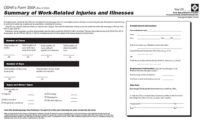History:
In 2013, OSHA issued a proposed rule to improve tracking of workplace injuries and illnesses through the electronic collection of establishment-specific injury and illness data to which OSHA currently does not have direct access. The agency held a public meeting in January 2014 and received comments on the proposal. After considering public comments, OSHA issued a final rule on April 29, 2016, that requires certain employers to electronically submit injury and illness data.
Compliance deadline:
The final rule takes effect Jan. 1, 2017, and reporting requirements will be phased in over two years, as follows:
Establishments with 250 or more employees must begin submitting information from Form 300A by July 1, 2017, and must submit information from all forms (300A, 300, and 301) by July 1, 2018. Beginning in 2019 and every year thereafter, the information must be submitted by March 2.
Establishments with 20-249 employees in certain high-risk industries must begin submitting information from Form 300A by July 1, 2017, and again by July 1, 2018. Beginning in 2019 and every year thereafter, the information must be submitted by March 2.
High-risk industries include: Agriculture; Utilities; Construction; Manufacturing; Wholesale Trade; Warehousing and Storage; Postal Service; Freight Trucking; Bus Transportation; Scheduled Air Transportation; Waste Collection, Treatment and Disposal; General medical and Surgical Hospitals, Nursing Care Facilities, and many more.
If you are not in either of these two categories, then you must submit information from the injury and illness records to OSHA only if OSHA notifies you to do so for an individual data collection.
How will electronic submission work?
OSHA will provide a secure website that offers three options for data submission. First, users will be able to manually enter data into a webform. Second, users will be able to upload a CSV file to process single or multiple establishments at the same time. Last, users of automated recordkeeping systems will have the ability to transmit data electronically via an API (application programming interface). The site is scheduled to go live in February 2017.
The OSHA website will include web forms for direct data entry and instructions for other means of submission (e.g. file uploads).
For establishments with 20-249 employees that are required to report, OSHA estimates that it will take a typical employer about 10 minutes to create an account and another 10 minutes to enter the required information from the Summary of Work-Related Injuries and Illnesses (Form 300A).
For establishments with 250 or more employees, OSHA estimates that it will take a typical employer about 10 minutes to create an account, 10 minutes to enter the required information from the Summary of Work-Related Injuries and Illnesses (Form 300A), and 12 minutes to enter the required information for each injury or illness recorded on their Log and Injury and Illness Incident Report forms (Forms 300 and 301).
Establishments must submit the information electronically and may not submit the information on paper. Employers who do not have the necessary equipment or internet connection may submit their data from a public facility, such as a library. OSHA also intends to provide an interface for entering data from a mobile device.
Does the rule require new recordkeeping information to be submitted?
No. The new requirement does not add to or change an employer's obligation to complete, retain, and certify injury and illness records. It only requires certain employers to electronically submit some of the information from these records to OSHA.
Why does OSHA address retaliation in this rule?
Section 11(c) of the Occupational Safety and Health Act already prohibits any person from discharging or otherwise discriminating against an employee who reports a fatality, injury, or illness. However, OSHA may not act under that section unless an employee files a complaint with OSHA within 30 days of the retaliation.
In contrast, under the final rule, OSHA will be able to cite an employer for retaliation even if the employee did not file a complaint, or if the employer has a program that deters or discourages reporting through the threat of retaliation. Often the point of retaliating against an employee who reports a hazard is to intimidate them from asserting their rights. This new authority is important because it gives OSHA the ability to protect workers who have been subject to retaliation, even when they cannot speak up for themselves. OSHA believes the rule will encourage employers to maintain accurate and complete injury records.
Is post-incident drug testing prohibited as a form of retaliation?
The rule does not prohibit drug testing of employees. It only prohibits employers from using drug testing, or the threat of drug testing, as a form of retaliation against employees who report injuries or illnesses. If an employer conducts drug testing to comply with the requirements of a state or federal law or regulation, the employer's motive would not be retaliatory and this rule would not prohibit such testing.
Does the rule allow an employer to have an employee incentive program?
This rule does not prohibit incentive programs. But employers must not create incentive programs that deter or discourage an employee from reporting an injury or illness. Incentive programs should encourage safe work practices and promote worker participation in safety-related activities.
How will OSHA use this recordkeeping data?
Electronic submission of establishment-specific injury and illness data will enable OSHA to use its enforcement and compliance assistance resources more efficiently. Analysis of the data will improve OSHA's ability to identify, target, and remove safety and health hazards, thereby preventing workplace injuries, illnesses, and deaths.
The agency will make the injury and illness data public, as encouraged by President Obama's Open Government Initiative. After removing any Personally Identifiable Information (PII) that could be used to identify individual employees, OSHA will post the data on osha.gov. Interested parties will be able to search and download the data. OSHA believes that posting timely, establishment-specific injury and illness data will provide valuable information to employers, employees, employee representatives, and researchers.
How will personal data be protected?
OSHA will not collect employee name, employee address, name of physician or other health care professional, or healthcare facility name and address if treatment was given away from the worksite. All of the case specific narrative information in employer reports will be scrubbed for Personally Identifiable Information (PII) using software that will search for, and de-identify, personally identifiable information before the data are posted.
Sponsor: www.industrysafe.com, 1-800-696-9110


